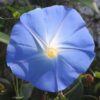A young American undergraduate student has made a monumental psychedelic discovery.
This week, West Virginia University informed the public that one of its microbiology scholars has discovered a new species of fungus growing on a particular variety of morning glory flower. Corinne Hazel’s find was made while working in the lab alongside the university’s plant and soil sciences expert Daniel Panaccione.
The school says she has now completed a mission that the late Albert Hofmann aimed to finish before his passing. He was the first to synthesize lysergic acid diethylamide (LSD) in 1938 by isolating compounds found in ergot fungus on rye.
“Hofmann hypothesized that a fungus in morning glories produced alkaloids similar to those in LSD,” the institution specified, “but the species remained a mystery until Hazel and Panaccione’s discovery.”
He knew that the morning glory plant had these alkaloids, but believed that they didn’t come from the plant itself. They likely came from a fungus growing on it, he rightly estimated.
Lysergic acid amide, an alkaloid similar to LSD, was known to be present on the seeds of the Ipomoea tricolor flower. Now, the world knows exactly where this psychoactive compound is derived from.
The researchers have named the fungus “Periglandula clandestina.” They published a study on it in the journal Mycologia on Apr. 22.
“This project has taken the better part of two years to get to this point and I am so excited to share Periglandula clandestina with the world!” Hazel said on social media last month.
Conditions the newly discovered fungus could help treat include depression, PTSD and substance use disorders. Orthodox LSD has shown recent promise for alleviating unpleasant symptoms associated with these afflictions.
“We had a ton of plants lying around and they had these tiny little seed coats,” Hazel said in the release from WVU. “We noticed a little bit of fuzz in the seed coat. That was our fungus.”
Despite evidence that ergot alkaloids were present in the flower, the fungus that Hazel just discovered has eluded researchers for decades. The attempts made by Hofmann and others to pinpoint it were futile.
Morning glory seeds are known to have been used by the Aztecs for divinatory and healing rituals, thereby enhancing the spiritual experience significantly.

The elusive novel fungus. Image credit: Mycologia
Read more: Beckley Psytech & atai Life Sciences to combine expertise in pivotal merger
Read more: Gilgamesh’s psychedelic drug demonstrates exceptional efficacy for treating depression
Follow Rowan Dunne on LinkedIn
rowan@mugglehead.com














